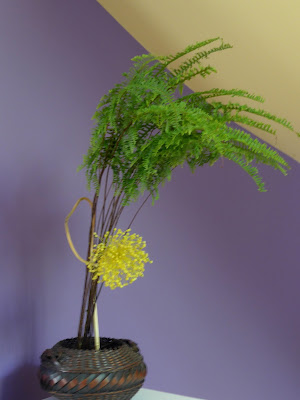 |
| This picture was taken through a fly-wire screen, hence its blurry appearance |
The juvenile kookaburra in the picture, above, landed on my kitchen window sill and stayed there long enough for me to get the camera and capture it. For some years now, we have had a pair of kookaburras coming to our back yard and been hand fed by Sam. We've watched as they produce two chicks every year. We know when they are nesting because only one comes to feed and when it has had enough it takes food in its beak and flies off, obviously, to feed the one sitting on the eggs.
When the chicks are still fledglings we hear their awkward and quite comical cry. Unlike the majestic call of the adults. When they are able to fly, the adults bring the chicks to our garden but they, themselves, sit up high guarding them while they learn to eat. The young remain with the parents to help with the next generation of chicks and only leave when the new chicks become independent. It's a fascinating family cycle.
We love having them visit and being a part of our lives but we, also, appreciate the services they render. Many times we've seen one of them swoop down and pick up a mouse or other rodent. They, also, keep me company whilst I'm working in the garden.
 |
| Perched on the rose arbour |
 |
| And on the rake handle over the bin |
We love these birds that have learnt to trust us but they are not very smart. In marked contrast is the cleverness of the ravens and magpies. They have observed that when we give meat to the kookaburras, they beat it against the tree branch to 'kill' it. This means that bits of the meat drop down and the very opportunistic magpies and ravens are quick to pick them up. They have, also observed and learnt the routine. When the kookaburras appear in our garden, Sam, whose office windows face the garden, usually will go out to feed them. Sometimes, however, he may delay, due to clients, phone calls etc. Then the magpie will come to his window making all kinds of sounds, to alert him that the kookaburras are here and he should come and feed them. Now, that's what I call clever!
And, now, back to ikebana.
Last week we had our first Sogetsu meeting for the year. The workshop was run by Lara Telford, who is the current recipient of the Norman and Mary Sparnon scholarship and, who has recently returned from Japan after three months study at headquarters. Lara's theme was number 48 of 'The Fifty Principles of Ikebana' - 'Remember there are always new,surprising themes and approaches to arranging Ikebana.
Lara requested that we plan and sketch a freestyle arrangement using only botanical materials. Then, at the workshop, she asked us to rethink our original plan and come up with something new.
I had planned to use 2 agave leaves and a garlic flower on a glass base that has two small holes. I was going to cut two sticks to about 10 cm and place in each hole, which would then, pierce the agave at the base, thus holding it upright. My very basic sketch is below and next to it is the my final piece.
 |
| Original plan |
 |
| Rethink |
Please go to Sogetsu Ikebana Victorian Branch for more information and photos.
In my class, last week, the senior students were given the theme from Book 5 - 'Glass Containers'. In this exercise, because the glass is transparent, the inside of the container is just as important as the outside and, sometimes, even more important. We can even create an arrangement only inside the container.
 |
| I used agapanthus seed heads and stems, both curved and straight. Although it looks as though the seed head on the right is touching the table, in fact, it isn't |
 |
| Nicole used New Zealand Flax and Nandina domestica |
 |
| Vicky's arrangement is a little hard to see - the container is up-side-down, with one flower head under and two over the container. There is, also, water in the centre |
 |
| Lucy used straight agapanthus stems and 2 bougainvillea flowers in a tall vase |
 |
| Bredenia used a type of Aeonium, featuring the interesting curves of the stems |
Below are two pieces with the theme from Book Four - 'Arrangement with Plants on a Wall'
 |
| Aurelia used a prostrate banksia stem and Singapore orchids |
 |
| I used gymea leaves and ivy |
Before I go, I'd like to give you details of our upcoming Ikebana International Exhibition:
Monday 5th – Friday 9th March
9.00 am – 5.00 pm
Bourke Place Foyer
600 Bourke St, Melbourne
Demonstration (Free): By our Lucy Papas
Tuesday 6th March 1.00 pm – 2.00 pm
‘Mistress Café’ Balcony, Bourke Place Foyer
Bye for now,
Emily









